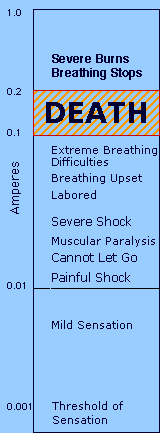Never been shocked by my battery till now
rgk1
Solar Expert Posts: 135 ✭✭✭
While watering batteries today I touched the RTS when moving insulation off. Got what felt like a shock. Touched it again and definitely got shocked (7th battery in the string). At first I thought maybe a short somewhere. Now I don't know. Put the meter on it and held the ground lead with my finger and put positive on last battery in the string. It is reading voltage that I assume should not be there. Ideas on where to begin? I Think I have touched the terminals in the past, but never got a shock.

4-Risen 320 watt in series/parallel, 8-215ah 6 volt GC2 batteries in series, Exeltech 1100 watt/48 volt inverter, Tristar 45 MPPT controller.
Comments
-
Update. I was standing on the ground barefoot. When I put shoes on, no shock. It is a negative battery ground so I guess this is normal? Silly me, don't touch the positive post of battery?
4-Risen 320 watt in series/parallel, 8-215ah 6 volt GC2 batteries in series, Exeltech 1100 watt/48 volt inverter, Tristar 45 MPPT controller. -
I have even gotten shocked (very light) with 24VDC... Warm/humid day, I was sitting on a grounded (to 24 VDC ground) metal rail with jeans on.
More or less, under 12 volts is usually "touch safe". And over 60 Volts is never touch safe per usual safety codes.
Assuming there is a path from battery negative bus to earth (ground rod, cold water pipe, etc.)--Then not surprised you got a shock.
-BillNear San Francisco California: 3.5kWatt Grid Tied Solar power system+small backup genset -
Here is a simple chart on current vs physical effect:
https://www.asc.ohio-state.edu/physics/p616/safety/fatal_current.html
Dry skin--High resistance. Damp with salt much lower resistance/easier to get a shock.
Current path from feet through left arm--Current path through heart and possible stoppage of heart. Shock from left foot to right foot, very low chance of affecting heart...
-BillNear San Francisco California: 3.5kWatt Grid Tied Solar power system+small backup genset -
I will consider myself lucky and lesson learned. It rained hard last night and today I was soaking wet with salty sweat. I was standing about 6ft from where the ground rod for the system is.
4-Risen 320 watt in series/parallel, 8-215ah 6 volt GC2 batteries in series, Exeltech 1100 watt/48 volt inverter, Tristar 45 MPPT controller. -
BB. said:Here is a simple chart on current vs physical effect:
https://www.asc.ohio-state.edu/physics/p616/safety/fatal_current.html
Dry skin--High resistance. Damp with salt much lower resistance/easier to get a shock.
Current path from feet through left arm--Current path through heart and possible stoppage of heart. Shock from left foot to right foot, very low chance of affecting heart...
-Bill
Wow! I am shocked ( :-) )at the low current values required to be lethal! I cannot help but wonder about the effect of voltage. I have been bitten by a 480v 3 phase contact (so 277v to ground) and a few hits at 120v/240v. I was trained 40 years ago to keep one hand in my back pocket to avoid providing a good ground path through my body.
I always have more questions than answers. That's the nature of life. -
Pick two levels... 0.010 amps and below is relatively safe. And 0.10 and above and approaching sever heart/breathing issues...The actual resistance of the body varies depending upon the points of contact and the skin condition (moist or dry). Between the ears, for example, the internal resistance (less the skin resistance) is only 100 ohms, while from hand to foot is closer to 500 ohms. The skin resistance may vary from 1000 ohms for wet skin to over 500,000 ohms for dry skin.1,000 Ohms for wet skin contact... And 500,000 Ohms for dry skin (numbers below are just for discussion/education--They are not hard numbers that anyone should use to determine "safe" or "dangerous" practices):
- V=IR
- V = 1,000 Ohms * 0.010 Amps = 10 Volts "safe" wet contact
- V = 500,000 Ohms * 0.010 Amps = 5,000 Volts "safe" dry contact (issues with arc through skin?)
- V = 1,000 Ohms * 0.10 Amps = 100 Volts "approaching death" wet contact
- V = 500,000 Ohms * 0.10 Amps = 500 Volts "approaching death" dry contact (issues with arc through skin?)
https://www.brighthubengineering.com/power-plants/89792-ac-and-dc-shock-comparison/
Over the years, OSHA and doctors have been treating electrical shock victims more seriously... In the "olden days" (as I understand)--Person gets up after a shock on 120 VAC or over--If they get up, they are "OK"... These days, even what was a "minor shock" can (will?) end up with an overnight stay to ensure there were no delayed effects from the shock.
-BillNear San Francisco California: 3.5kWatt Grid Tied Solar power system+small backup genset
Categories
- All Categories
- 233 Forum & Website
- 141 Solar Forum News and Announcements
- 1.4K Solar News, Reviews, & Product Announcements
- 199 Solar Information links & sources, event announcements
- 900 Solar Product Reviews & Opinions
- 256 Solar Skeptics, Hype, & Scams Corner
- 22.5K Solar Electric Power, Wind Power & Balance of System
- 3.5K General Solar Power Topics
- 6.7K Solar Beginners Corner
- 1K PV Installers Forum - NEC, Wiring, Installation
- 2.1K Advanced Solar Electric Technical Forum
- 5.6K Off Grid Solar & Battery Systems
- 429 Caravan, Recreational Vehicle, and Marine Power Systems
- 1.1K Grid Tie and Grid Interactive Systems
- 656 Solar Water Pumping
- 816 Wind Power Generation
- 624 Energy Use & Conservation
- 623 Discussion Forums/Café
- 315 In the Weeds--Member's Choice
- 75 Construction
- 125 New Battery Technologies
- 108 Old Battery Tech Discussions
- 3.8K Solar News - Automatic Feed
- 3.8K Solar Energy News RSS Feed